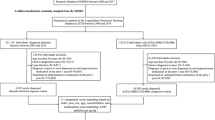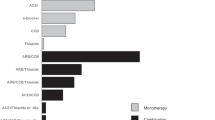Abstract
This study was conducted to assess the use of angiotensin receptor blockers (ARBs) in European paediatric patients experiencing essential hypertension. This was a retrospective analysis of the IMS MIDAS Prescribing Insight Medical Database. Five major important European markets, including France, Germany, Italy, Spain and the UK were studied for the usage of ARBs as either a monotherapy or fixed-dose combination (FDC) therapy . Paediatric patients with essential hypertension were identified using ICD-10 codes, and anatomical therapeutic chemical (ATC) classification was used to identify major classes of antihypertensives. Projected prescription data for paediatric patients (<18 years) in the time period of October 2005 to September 2006 were analysed. Special emphasis was placed on the category of 6–17 years of age, as many ARBs were recommended in children above 6 years of age. Out of 242 405 estimated paediatric patients with hypertension, 222 033 (91.6%) were diagnosed with essential hypertension. Out of 230 220 projected prescriptions dispensed in these essential hypertensives, approximately 76.2% were for patients in the category of 6–17 years of. In the age group of 6–17 years, ARBs constituted 25.5% of the projected prescriptions, with 10.6% in the form of FDC of ARBs with hydrochlorothiazides (HCTz). Projected ARB prescription usage, either as a monotherapy or as an FDC with HCTz, was higher in Italy (35.7%), France (30.9%) and Spain (28.1%), but was lower in Germany (5.3%), and non-existent in the United Kingdom. Valsartan-based and losartan-based FDCs were commonly used in the age range of 6–17 years, and accounted for 39. and 13.9% of the projected prescription volume in the ARB–FDC category, respectively. In a majority of the important European markets, paediatric hypertensive patients in the age range of 6–17 years are often treated with ARB monotherapy or FDC therapy. Some ARBs lack necessary clinical studies to support its use in treating essential hypertension in paediatric patients.
This is a preview of subscription content, access via your institution
Access options
Subscribe to this journal
Receive 12 digital issues and online access to articles
$119.00 per year
only $9.92 per issue
Buy this article
- Purchase on Springer Link
- Instant access to full article PDF
Prices may be subject to local taxes which are calculated during checkout

Similar content being viewed by others
References
Wolf-Maier K, Cooper RS, Banegas JR, Giampaoli S, Hense HW, Joffres M et al. Hypertension prevalence and blood pressure levels in 6 European countries, Canada, and the United States. JAMA 2003; 289: 2363–2369.
Health in the European Union. Special Eurobarometer ( http://ec.europa.eu/health/ph_publication/eb_health_en.pdf. Last accessed 07/07/08), 1-52. 2007. Ref Type: Electronic Citation.
Antikainen R, Jousilahti P, Tuomilehto J . Systolic blood pressure, isolated systolic hypertension and risk of coronary heart disease, strokes, cardiovascular disease and all-cause mortality in the middle-aged population. J Hypertens 1998; 16: 577–583.
O’Donnell CJ, Ridker PM, Glynn RJ, Berger K, Ajani U, Manson JE et al. Hypertension and borderline isolated systolic hypertension increase risks of cardiovascular disease and mortality in male physicians. Circulation 1997; 95: 1132–1137.
Trenkwalder P, Hendricks P, Schoniger R, Rossberg J, Lydtin H, Hense HW . Hypertension as a risk factor for cardiovascular morbidity and mortality in an elderly German population; the prospective STEPHY II study. Starnberg Study on Epidemiology of Parkinsonism and Hypertension in the Elderly. Eur Heart J 1999; 20: 1752–1756.
Zanchetti A, Hansson L, Dahlof B, Elmfeldt D, Kjeldsen S, Kolloch R et al. Effects of individual risk factors on the incidence of cardiovascular events in the treated hypertensive patients of the Hypertension Optimal Treatment Study. HOT Study Group. J Hypertens 2001; 19: 1149–1159.
Mitsnefes MM . Hypertension in children and adolescents. Pediatr Clin North Am 2006; 53: 493–512.
Varda NM, Gregoric A . A diagnostic approach for the child with hypertension. Pediatr Nephrol 2005; 20: 499–506.
Flynn JT . Evaluation and management of hypertension in childhood. Prog Pediatr Cardiol 2001; 12: 177–188.
Coody DK, Yetman RJ, Portman RJ . Hypertension in children. J Pediatr Health Care 1995; 9: 3–11.
Pinto A, Roldan R, Sollecito TP . Hypertension in children: an overview. J Dent Educ 2006; 70: 434–440.
Luma GB, Spiotta RT . Hypertension in children and adolescents. Am Fam Physician 2006; 73: 1558–1568.
Chiolero A, Madeleine G, Gabriel A, Burnier M, Paccaud F, Bovet P . Prevalence of elevated blood pressure and association with overweight in children of a rapidly developing country. J Hum Hypertens 2007; 21: 120–127.
Chiolero A, Cachat F, Burnier M, Paccaud F, Bovet P . Prevalence of hypertension in schoolchildren based on repeated measurements and association with overweight. J Hypertens 2007; 25: 2209–2217.
Schiel R, Beltschikow W, Kramer G, Stein G . Overweight, obesity and elevated blood pressure in children and adolescents. Eur J Med Res 2006; 11: 97–101.
Friedman AL . Approach to the treatment of hypertension in children. Heart Dis 2002; 4: 47–50.
Robinson RF, Nahata MC, Batisky DL, Mahan JD . Pharmacologic treatment of chronic pediatric hypertension. Paediatr Drugs 2005; 7: 27–40.
Novartis Garners Pediatric Exclusivity for Diovan. FDAnews Drug Daily Bulletin ( http://www.fdanews.com/newsletter/article?articleId=97384&issueId=10606Last Accessed 07/07/2008) 4[163]. 7 A.D. Ref Type: Electronic Citation.
The fourth report on the diagnosis, evaluation, and treatment of high blood pressure in children and adolescents. Pediatrics 2004; 114: 555–576.
Shah SS, Hall M, Goodman DM, Feuer P, Sharma V, Fargason Jr C et al. Off-label drug use in hospitalized children. Arch Pediatr Adolesc Med 2007; 161: 282–290.
Dell’Aera M, Gasbarro AR, Padovano M, Laforgia N, Capodiferro D, Solarino B et al. Unlicensed and off-label use of medicines at a neonatology clinic in Italy. Pharm World Sci 2007; 29: 361–367.
Yoon EY, Dombkowski KJ, Rocchini A, Lin JJ, Davis MM . Off-label utilization of antihypertensive medications in children. Ambul Pediatr 2007; 7: 299–303.
Livermore DM, Reynolds R, Stephens P, Duckworth G, Felmingham D, Johnson AP et al. Trends in penicillin and macrolide resistance among pneumococci in the UK and the Republic of Ireland in relation to antibiotic sales to pharmacies and dispensing doctors. Int J Antimicrob Agents 2006; 28: 273–279.
Wong IC, Murray ML, Camilleri-Novak D, Stephens P . Increased prescribing trends of paediatric psychotropic medications. Arch Dis Child 2004; 89: 1131–1132.
Wong IC, Murray ML . The potential of UK clinical databases in enhancing paediatric medication research. Br J Clin Pharmacol 2005; 59: 750–755.
Arar MY, Hogg RJ, Arant Jr BS, Seikaly MG . Etiology of sustained hypertension in children in the southwestern United States. Pediatr Nephrol 1994; 8: 186–189.
Hanna JD, Chan JC, Gill Jr JR . Hypertension and the kidney. J Pediatr 1991; 118: 327–340.
Blowey DL . Safety of the newer antihypertensive agents in children. Expert Opin Drug Saf 2002; 1: 39–43.
Sadowski RH, Falkner B . Hypertension in pediatric patients. Am J Kidney Dis 1996; 27: 305–315.
Bianchetti MG, Ammenti A, Avolio L, Bettinelli A, Bosio M, Fossali E et al. Prescription of drugs blocking the renin-angiotensin system in Italian children. Pediatr Nephrol 2007; 22: 144–148.
Author information
Authors and Affiliations
Corresponding author
Appendix 1
Appendix 1
Rights and permissions
About this article
Cite this article
Balkrishnan, R., Phatak, H., Gleim, G. et al. Assessment of the use of angiotensin receptor blockers in major European markets among paediatric population for treating essential hypertension. J Hum Hypertens 23, 420–425 (2009). https://doi.org/10.1038/jhh.2008.139
Received:
Revised:
Accepted:
Published:
Issue Date:
DOI: https://doi.org/10.1038/jhh.2008.139
Keywords
This article is cited by
-
Authors’ response to Bachmann and Hoffman’s comments on psychopharmacological prescriptions for people with autism spectrum disorder (ASD): a multinational study
Psychopharmacology (2015)
-
Psychopharmacological prescriptions for people with autism spectrum disorder (ASD): a multinational study
Psychopharmacology (2014)



